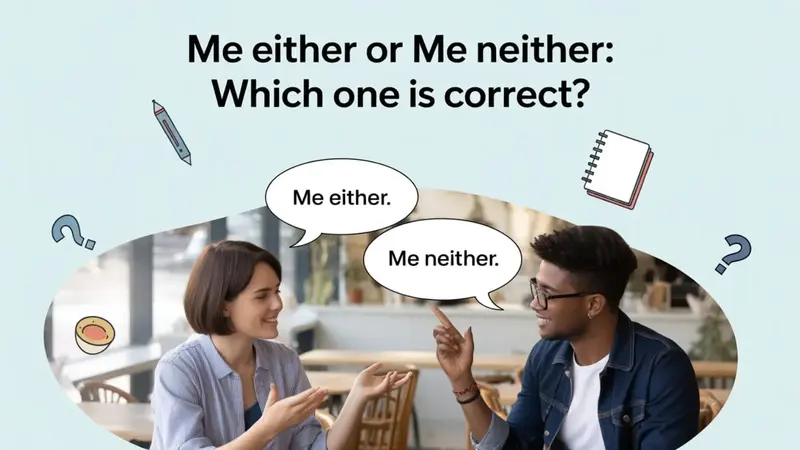Have you ever paused mid-conversation wondering if you should say “me either” or “me neither”?
You’re definitely not alone—I’ve been there too! Many English learners (and even fluent speakers) mix these up because they sound so similar.
If you’re someone who wants to speak or write English more naturally, this is for you.
In this guide, I’ll break down the real difference between me either and me neither in simple terms. By the end, you’ll know exactly which one to use in every situation—no more second-guessing in conversations!
💬 Me Either or Me Neither – Quick Answer
The correct and most commonly accepted phrase is “Me neither” ✅
Explanation:
You use “me neither” to agree with a negative statement.
- ❌ I don’t like spicy food.
- ✅ Me neither.
“Me either” is less common and informal, used mainly in American English in casual speech.
- ❌ I don’t have time for that.
- 👍 Me either. (spoken, informal)
So:
| Usage | Correct Form | Example |
|---|---|---|
| Formal writing | Me neither | “I don’t agree with that.” → “Me neither.” |
| Casual speech (US) | Me either | “I don’t know.” → “Me either.” |
📚 The Origin of “Me Either or Me Neither”
The word “neither” comes from Old English næther, meaning “not either.” Historically, it was used to express agreement with a negative or to negate both options.
On the other hand, “either” originally meant “one or the other,” but in negative sentences, it took on a meaning similar to “too” or “also.”
That’s why both phrases seem correct—grammar evolved differently across regions.
Over time, “me neither” became standard, especially in British and formal English, while “me either” stayed popular in informal American usage.
🇬🇧🇺🇸 British English vs American English Spelling
Both forms are understood, but usage differs:
| Region | Common Form | Formality | Example |
|---|---|---|---|
| 🇬🇧 UK | Me neither | Formal & informal | “I can’t swim.” → “Me neither.” |
| 🇺🇸 USA | Me either | Informal only | “I don’t like it.” → “Me either.” |
| 🇨🇦 Canada | Me neither | Preferred | “I don’t agree.” → “Me neither.” |
| 🇦🇺 Australia | Me neither | Standard | “I don’t drive.” → “Me neither.” |
Summary:
- Use “me neither” in writing or formal contexts.
- Use “me either” in spoken, friendly, or casual conversations—especially in the US.
🧭 Which Spelling Should You Use?
Here’s a simple guide:
| Audience | Recommended Form | Reason |
|---|---|---|
| US Audience | Me either (casual), Me neither (formal) | Both common, but context matters |
| UK/Commonwealth | Me neither | Standard grammar |
| Global/Online Writing | Me neither | Safest, most widely accepted |
Pro Tip:
If you’re unsure, always choose “me neither.” It’s grammatically correct everywhere and fits both spoken and written English.
❌ Common Mistakes with “Me Either or Me Neither”
Here are some frequent errors and their corrections:
| Mistake | Correction | Explanation |
|---|---|---|
| “I don’t like it. Me too.” | “I don’t like it. Me neither.” | “Me too” agrees with positive statements only. |
| “I can’t go. Me either.” (formal) | “I can’t go. Me neither.” | “Me either” is informal; avoid in formal writing. |
| “Me neither do I.” | “Neither do I.” or “Me neither.” | Don’t combine both structures. |
| “I don’t like coffee either.” | ✅ Correct | This structure is fine; it uses “either” within a sentence, not as a standalone reply. |
🗣️ “Me Either or Me Neither” in Everyday Examples
Let’s see how these appear in real contexts:
📧 In Emails:
- “I don’t think that’s necessary.” → “Me neither.” (Professional tone)
📰 In News/Articles:
- “I don’t see that policy working—me neither,” said the expert.
💬 On Social Media:
- “I don’t trust that trend.” → “Me either 😂” (Casual, friendly)
🎓 In Formal Writing:
- Always choose “me neither.” It fits academic, business, or published work.
📊 “Me Either or Me Neither” – Google Trends & Usage Data
According to Google Trends, “me neither” dominates globally 🌍, especially in:
- The UK 🇬🇧
- Canada 🇨🇦
- Australia 🇦🇺
Meanwhile, “me either” ranks higher in:
- The United States 🇺🇸
- Philippines 🇵🇭 (due to American English influence)
| Country | Popular Form | Trend Strength |
|---|---|---|
| USA | Me either | 🔹 65% |
| UK | Me neither | 🔸 90% |
| Canada | Me neither | 🔸 85% |
| Australia | Me neither | 🔸 88% |
Insight:
“Me either” appears more in casual online speech, while “me neither” is favored in education, media, and formal writing.
❓ FAQs About “Me Either or Me Neither”
1. Which is grammatically correct – me either or me neither?
👉 “Me neither” is grammatically correct and widely accepted.
2. Can I use ‘me either’ in writing?
Only in casual or dialogue-style writing, not in formal essays or emails.
3. Is ‘me either’ wrong?
Not wrong, just informal and mostly used in American English.
4. Can I say ‘me either’ after a positive sentence?
❌ No. “Either” and “neither” only agree with negative statements.
5. What’s the opposite of ‘me neither’?
✅ “Me too.” (Used to agree with positive statements.)
6. Can I say ‘neither me’ instead of ‘me neither’?
❌ No. “Neither me” sounds unnatural as a standalone phrase.
7. Is there a difference in meaning between the two?
Meaning is the same (“I agree with your negative statement”), but formality and region differ.
🏁 Conclusion
When choosing between “me either” and “me neither,” remember this: both express agreement with a negative idea—but “me neither” is the grammatically standard and globally accepted version.
Use “me either” only in informal American speech or casual online chats.
For emails, reports, or academic writing, always pick “me neither.” It’s clear, correct, and professional.
The key is to match your tone and audience—sound natural, but stay grammatically right.
With this guide, you can confidently respond to any “I don’t…” statement without hesitation! 💪

I’m Emma Collins, a grammar expert and author at Grammarnestly.com. I love helping readers master English with simple, practical grammar guides.
When I’m not writing, I enjoy reading, coffee, and exploring the beauty of language.



